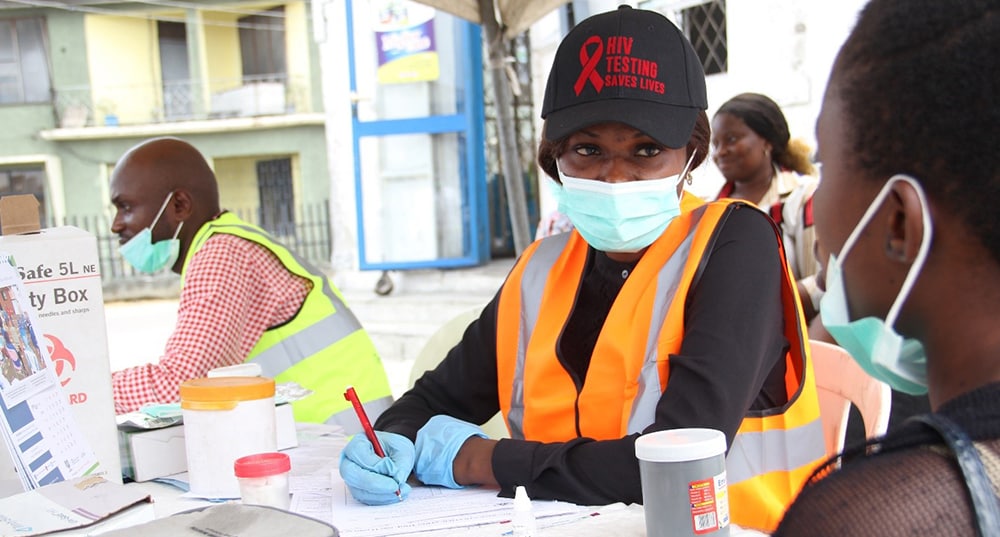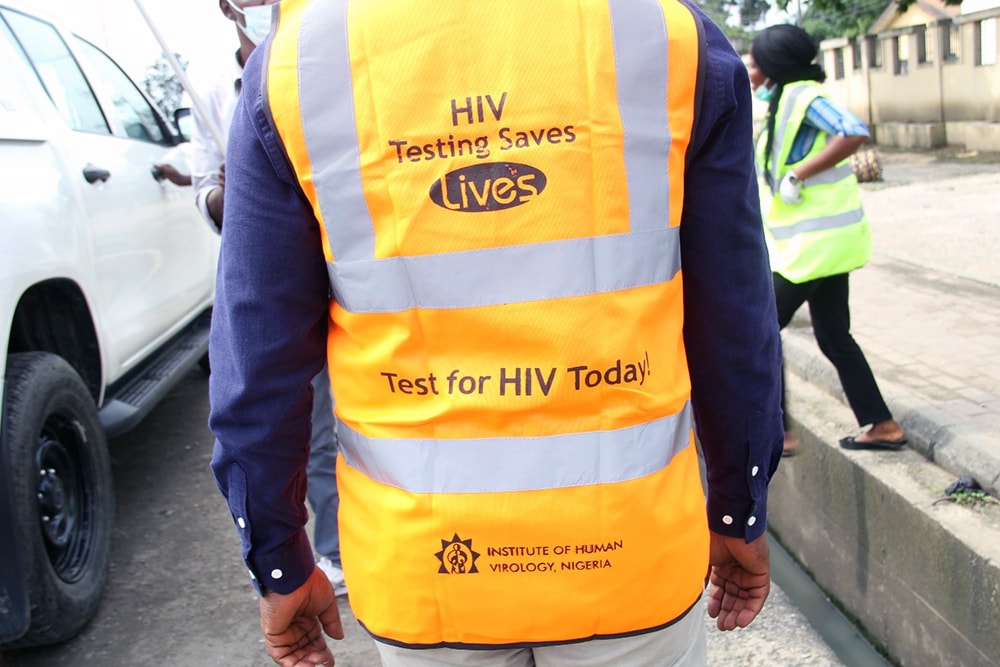At a glance
This story shares the unique challenges Nigeria faces as the country with the fourth largest HIV epidemic. With support from CDC and PEPFAR, the CDC-Nigeria team set out to significantly expand HIV treatment and get the epidemic under control.

Background
Nigeria, the most populous country in Africa, is home to the fourth largest HIV epidemic in the world. The country also has one of the highest rates of new infections in sub-Saharan Africa.
For decades, the country was unable to efficiently identify people living with HIV and begin their treatment. As a result, they consistently fell short of meeting the UNAIDS' (Joint United Nations Programme on HIV/AIDS) goals for HIV epidemic control.
That all changed in 2018, when the country's leadership, with support from CDC and the U.S. President's Emergency Plan for AIDS Relief (PEPFAR), launched a nationwide household survey. The survey confirmed that less than half of Nigeria's 1.9 million people living with HIV were receiving lifesaving HIV treatment. It also identified precisely where these individuals were residing.
With these data, the CDC-Nigeria team set out to implement an ambitious approach to significantly expand HIV treatment and put Nigeria on the path to epidemic control.
Nigeria's HIV treatment surge

In April 2019, CDC and partners launched an HIV anti-retroviral treatment (ART) usrge. The goal was to increase HIV testing and expand access to lifesaving treatment for people living with HIV, specifically in Benue, Delta, Enugu, Gombe, Imo, Lagos, Nasarawa, and Rivers, and the Federal Capital Territory.
CDC and partners focused on these states due to their high numbers of untreated individuals living with HIV. An innovative operational platform, CIRAS (Comprehensive, Integrated, Resilient ART System), was also developed and implemented in the nine states to support this effort.
Furthermore, CDC and partners established incident command structures in each of the states. Each structure was led by an operations chief tasked with overseeing HIV service delivery efforts in that area. This included:
- Working closely with community leaders.
- Capturing key data.
- Identifying and solving challenges to improve access to treatment.
On a weekly basis, operations chiefs and other CDC experts collected the site-level data on HIV testing and treatment. They then analyzed them via a shared, collaborative dashboard. The experts used these data to continually adapt and improve HIV testing and treatment efforts within the communities who needed them most.
Surge accomplishments
In each state, the Ministry of Health, CDC and its implementing partners worked with community leaders to launch a combination of proven HIV interventions. The interventions were layered in such a way to bring about the greatest impact.
The results were immediate and impressive. An analysis published in CDC's Morbidity and Mortality Weekly Report (MMWR) showed that, even in the midst of the COVID-19 pandemic, the first 18-months of the Nigeria HIV treatment Surge resulted in a significant increase. The total number of people diagnosed with HIV who are now receiving treatment also increased by 65% in only a year and a half.
CDC leaders in Nigeria and Atlanta shared insights gained from the initial nine states to partners operating in nine additional Nigerian states. As a result, the Nigeria HIV treatment Surge increased the number of people living with HIV in these 18 states from 454,000 in 2019 to 903,000 in 2021. In other words, the number of people treated for HIV doubled in just two years.
Jahun attributes the program's success to its use of local, real-time data to help CDC and local experts refine and adjust their efforts on the ground for the greatest impact.
"At one point," he explains, "the data highlighted that not enough people were being tested in several areas. By having access to that information in real time and being able to rapidly pivot and increase testing, we were able to almost double the number of tests and the number of positive case findings in those areas."
A community-led effort
Dr. Emilio Dirlikov, lead author of the study and Acting HIV Program Director for CDC-Nigeria in early 2021, emphasized the importance of engaging with local communities. Particularly, he highlighted the vital role community health care workers (CHW) play.
CDC and partners trained and worked alongside local CHW who played key roles in daily program operations. This approach, says Dr. Dirlikov, allowed the effort to "get real data, reach real people, and achieve real results."

For example, in several states, CHWs were able to engage with community leaders. They would emphasize the importance of HIV testing and other health screenings integrated into the Surge outreach efforts. The leaders, in turn, would send town criers throughout the community. These criers alerted members to the screenings offered by CDC and the Ministry of Health. Consequently, the program was able to engage large crowds of community members to get tested for HIV and other health screenings.
Davis' story
Davis Akuye is one of the CHWs who helped support the Nigeria HIV treatment Surge. A resident of Rivers state, he has seen the devastation HIV has brought to his community first-hand.
As part of his job, Davis goes door to door, visiting his community members to:
- Pay daily visits.
- Provide information.
- Test for HIV.
- Link them to local HIV treatment services.
He recalls one particular incident where he was able to make a powerful impact.
"There was one client whose girlfriend tested positive for HIV," he recalls. "He was very upset and very afraid to get tested because he thought he had also contracted the virus," he said. "Because we are from the same community, with the same language and the same understandings, I could help him understand the importance of getting tested."
Ultimately the client learned he was HIV negative, and at Davis' urging, began taking pre-exposure prophylaxis (PrEP) to protect himself from the virus. At the same time, the client's girlfriend was initiated on HIV treatment. "Today, they are a happy, healthy married couple," he says proudly.
Looking to the future
Ultimately, the Nigerian ART Surge initiated HIV treatment for over 450,00 individuals between April 2019 and March 2021. Study authors say this is a herculean feat, considering the country had only initiated a total of 450,000 people on ART over the previous 17 years. Furthermore, the Surge effort achieved these gains with little or no changes to the overall budget.
More work to be done
However, program leaders say there is still more work to be done. In Nigeria and other places throughout the world, many people remain unaware of their HIV status. Improvements in HIV testing strategies, especially among those at high risk of infection, remain critical. Quickly linking people with HIV to treatment, retaining them, and helping them sustain viral suppression are also top priorities to reduce HIV transmission and HIV-related deaths. These initiatives are also core to the UNAIDS' global goals to achieve HIV epidemic control world-wide.
Program expansion
As the program continues to expand across Nigeria, more and more evidence points to its potential to be replicated in other settings. According to CDC HIV Care and Treatment Branch Chief, Dr. Tedd Ellerbrock, the Nigeria HIV treatment Surge and its successes can serve as a model for other countries around the world battling HIV epidemics and other health conditions.
"Very few of us in medicine and public health have the opportunity to do what we've done in Nigeria. The PEPFAR program in Nigeria has helped over 450,000 people access lifesaving therapy. Try and put your arms around that. We've made an enormous difference in the lives of 450,000 souls," said Ellerbrock.
Dirlikov adds that the novel approach could also generate momentum domestically. Here in the U.S., he points out, approximately 1.2 million people have been diagnosed with HIV and nearly 40,000 people become newly diagnosed each year.
But for many like Dr. Odafe, the success of the Surge hits much closer to home.
